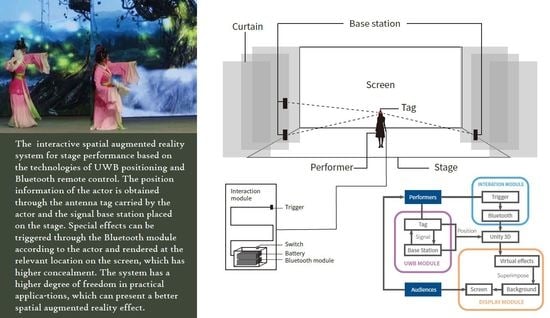Design of an Interactive Spatial Augmented Reality System for Stage Performance Based on UWB Positioning and Wireless Triggering Technology
Abstract
:1. Introduction
2. System Design and Implementation
2.1. System Design
2.2. Tracking and Fusing
2.3. Interaction
3. Results and Application
4. Conclusions and Discussion
Author Contributions
Funding
Conflicts of Interest
References
- Chen, Y.; Wang, Y.; Wu, Z.; Li, J. Research and realization of stage augmented reality system (in Chinese). Comput. Eng. Appl. 2018, 54, 11–17. Available online: http://www.cnki.com.cn/Article/CJFDTotal-JSGG201803002.htm (accessed on 1 February 2019).
- Lee, J.; Kim, Y.; Heo, M.H.; Kim, D.; Shin, B.S. Real-time projection-based augmented reality system for dynamic objects in the performing arts. Symmetry 2015, 7, 182–192. [Google Scholar] [CrossRef]
- Mine, M.; Rose, D.; Yang, B.; van Baar, J.; Grundhofer, A. Projection-based augmented reality in disney theme parks. Computer 2012, 45, 32–40. [Google Scholar] [CrossRef]
- Alexiadis, D.S.; Kelly, P.; Daras, P.; O’Connor, N.E.; Boubekeur, T.; Ben Moussa, M. Evaluating a dancer’s performance using kinect-based skeleton tracking. In Proceedings of the 19th ACM international conference on Multimedia, Scottsdale, AR, USA, November 28–December 1 2011; pp. 659–662. [Google Scholar]
- Marner, M.R.; Haren, S.M.; Gardiner, M.; Thomas, B.H. Exploring interactivity and augmented reality in theater: A case study of Half Real. In Proceedings of the IEEE International Symposium on Mixed and Augmented Reality-Arts, Media, and Humanities, Atlanta, GA, USA, 5–8 November 2012. [Google Scholar] [CrossRef]
- Clay, A.; Couture, N.; Nigay, L.; De La Rivière, J.-B.; Martin, J.-C.; Courgeon, M.; Desainte-Catherine, M.; Orvain, E.; Girondel, V.; Domenger, G. Interactions and systems for augmenting a live dance performance. In Proceedings of the IEEE International Symposium on Mixed and Augmented Reality-Arts, Media, and Humanities, Atlanta, GA, USA, 5–8 November 2012. [Google Scholar] [CrossRef]
- Zhang, Y.; Ma, P.F.; Zhu, Z.Q. Integrating performer into a real-time augmented reality performance spatially by using a multi-sensory prop. In Proceedings of the 23rd ACM Symposium on Virtual Reality Software and Technology, Gothenburg, Sweden, 8–10 November 2017. [Google Scholar] [CrossRef]
- Zhang, Y.X.; Ma, P.F.; Zhu, Z.Q. Magic Props: A Multi-sensory System Fusing Virtual Effects in Live Drama Performance Spatially. In Proceedings of the International Conference on Culture and Computing (Culture and Computing 2017), Kyoto, Japan, 10–12 September 2017. [Google Scholar] [CrossRef]












© 2019 by the authors. Licensee MDPI, Basel, Switzerland. This article is an open access article distributed under the terms and conditions of the Creative Commons Attribution (CC BY) license (http://creativecommons.org/licenses/by/4.0/).
Share and Cite
Zhang, Y.; Shen, Y.; Zhang, W.; Zhu, Z.; Ma, P. Design of an Interactive Spatial Augmented Reality System for Stage Performance Based on UWB Positioning and Wireless Triggering Technology. Appl. Sci. 2019, 9, 1318. https://doi.org/10.3390/app9071318
Zhang Y, Shen Y, Zhang W, Zhu Z, Ma P. Design of an Interactive Spatial Augmented Reality System for Stage Performance Based on UWB Positioning and Wireless Triggering Technology. Applied Sciences. 2019; 9(7):1318. https://doi.org/10.3390/app9071318
Chicago/Turabian StyleZhang, YanXiang, YiRun Shen, WeiWei Zhang, ZiQiang Zhu, and PengFei Ma. 2019. "Design of an Interactive Spatial Augmented Reality System for Stage Performance Based on UWB Positioning and Wireless Triggering Technology" Applied Sciences 9, no. 7: 1318. https://doi.org/10.3390/app9071318
APA StyleZhang, Y., Shen, Y., Zhang, W., Zhu, Z., & Ma, P. (2019). Design of an Interactive Spatial Augmented Reality System for Stage Performance Based on UWB Positioning and Wireless Triggering Technology. Applied Sciences, 9(7), 1318. https://doi.org/10.3390/app9071318





